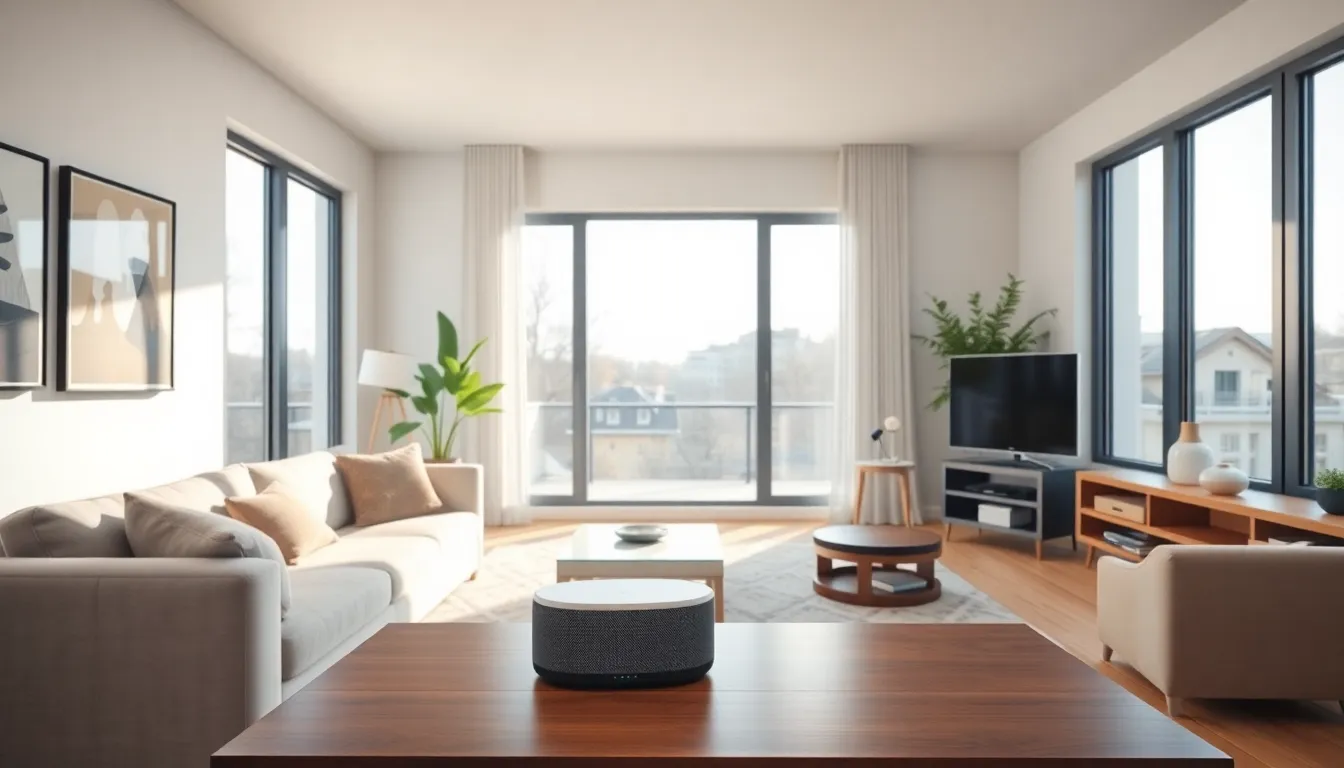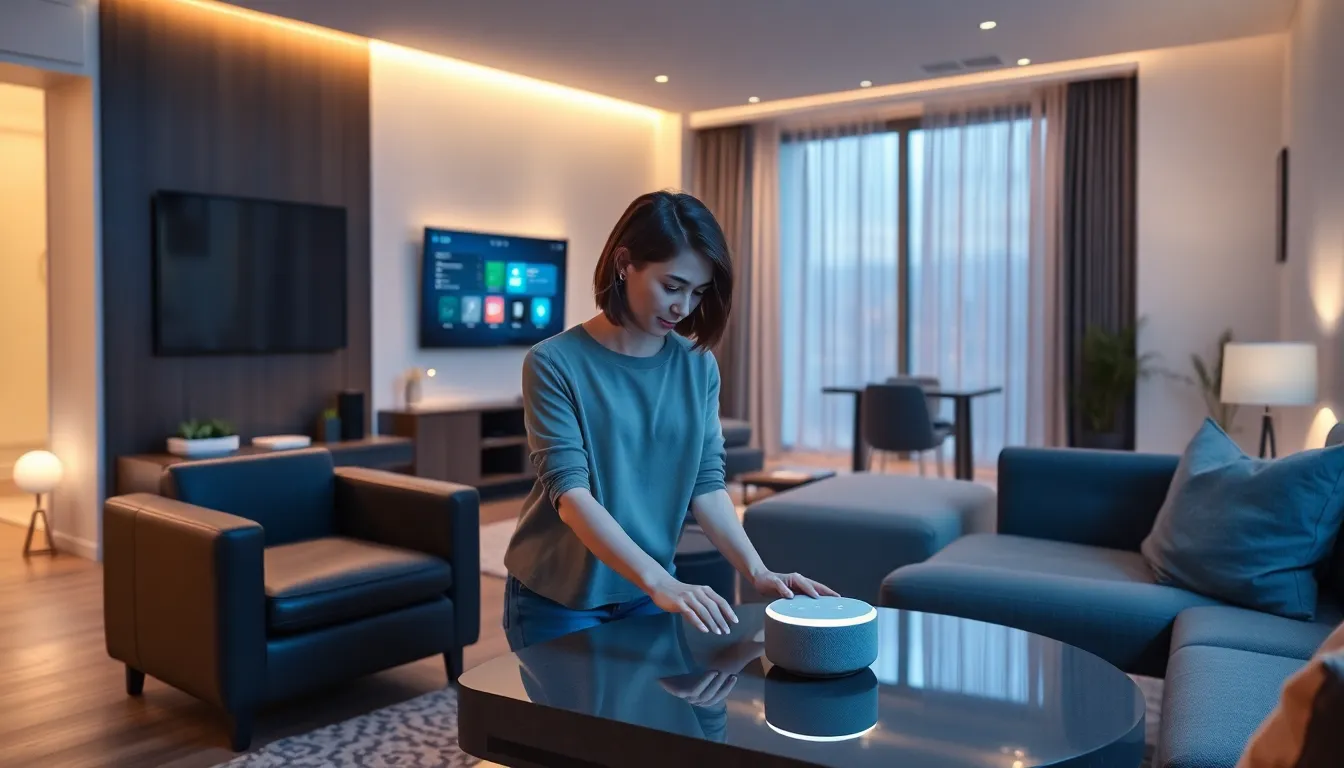Table of Contents
ToggleImagine a home that knows you better than your best friend. A place where your coffee brews itself just as you stumble out of bed and the lights dim to the perfect movie-watching glow—all while you’re still in your pajamas. Welcome to the world of modern smart homes, where technology transforms everyday living into a seamless experience.
These homes aren’t just for tech enthusiasts or the ultra-rich. They’re becoming accessible to everyone, making life easier, safer, and a tad more entertaining. From voice-activated assistants to smart thermostats that learn your habits, the possibilities are endless. So, buckle up as we dive into how these innovations are changing the way we live, one gadget at a time, and why your home might just be the next one to get a high-tech makeover.
Overview of Modern Smart Homes
Modern smart homes integrate advanced technology into daily living spaces. These homes utilize interconnected devices to enhance convenience, efficiency, and security. Homeowners benefit from features like automated lighting, which adjusts according to preferences, and smart security systems that monitor properties in real-time.
Voice-activated assistants streamline daily tasks. These assistants respond to commands, allowing users to control various functions without physical interaction. Smart thermostats optimize energy consumption by learning user habits, which leads to cost savings on utility bills.
Home automation systems promote a customized atmosphere. Examples include smart speakers that play music, smart blinds that adjust for light, and smart appliances that facilitate cooking. Each device works in sync, creating a cohesive smart ecosystem.
Enhancements in safety are significant. Smart smoke detectors alert homeowners of hazards more efficiently, while smart locks provide secure access control. These systems offer peace of mind, especially when users are away from home.
Accessibility rises for a broader audience. Modern smart homes are not just for tech-savvy individuals; adaptable devices cater to different needs, making them suitable for all age groups. Increased affordability and wider availability contribute to the trend of smart home adoption.
The evolution of technology has made smart homes increasingly practical. Innovations emerge regularly, expanding the range of available solutions for homeowners seeking enhanced living experiences. Each innovation aims to simplify life, providing consistent support for a busy lifestyle.
Key Features of Modern Smart Homes

Modern smart homes showcase a variety of innovative features that enhance daily living. These systems work together to create an efficient, secure, and enjoyable environment.
Home Automation Systems
Automation systems play a crucial role in modern smart homes. Devices such as smart speakers, blinds, and appliances interact seamlessly with each other. Users can control lighting, temperature, and entertainment systems through voice commands or mobile apps. Integration fosters convenience, as routines can be scheduled and adjusted based on personal preferences. Advanced systems even allow homeowners to monitor their homes remotely, ensuring everything operates smoothly. By providing personalized experiences, automation elevates comfort and enhances everyday life.
Energy Efficiency
Energy efficiency stands out as a significant benefit of smart homes. Smart thermostats can adapt to user habits, optimizing heating and cooling, which lowers energy costs. Lighting systems equipped with sensors adjust brightness according to natural light availability, reducing unnecessary electricity use. Additionally, smart appliances operate efficiently, minimizing waste of resources. Reports indicate that homeowners can experience up to 30% savings on energy bills through these technologies. This focus on energy efficiency not only lowers expenses but also contributes to sustainability efforts.
Security and Safety in Smart Homes
Smart homes prioritize security and safety through advanced technology that protects properties and occupants. Homeowners benefit from innovations that provide enhanced peace of mind.
Smart Cameras and Alarms
Smart cameras and alarms play a crucial role in securing homes. These devices offer real-time surveillance, enabling homeowners to monitor their properties from anywhere. Many systems feature motion detection, sending alerts to smartphones when unusual activity is detected. Integration with home automation allows seamless control, so alarms can be activated remotely. High-definition video quality provides clear imagery, aiding in evidence collection if incidents occur. Users can access camera feeds via mobile apps, ensuring constant visibility of their surroundings.
Remote Monitoring
Remote monitoring features elevate security measures for smart homes. Systems allow users to track home status from far away through smartphones or tablets. Notifications about door openings, temperature fluctuations, or alarm triggers keep homeowners informed. Some platforms utilize machine learning algorithms, improving accuracy in distinguishing between regular activity and potential intrusions. Monitoring services often come with 24/7 professional oversight, providing an extra layer of protection. Smart doorbells with video capability allow occupants to see and communicate with visitors without needing to open the door, further enhancing safety.
Benefits of Modern Smart Homes
Modern smart homes offer numerous advantages that simplify everyday living. Convenience ranks as one of the primary benefits. Users control devices like lights, thermostats, and entertainment systems from their smartphones or through voice commands. Efficiency stands out with automated systems that maximize energy usage. Smart thermostats, for example, adjust settings based on individual habits, leading to significant energy bill reductions.
Increased security also captivates homeowners. Technologies like smart cameras and alarms deliver real-time alerts for unusual activity. Property owners monitor their homes remotely, offering peace of mind when they are away. Integration of these security systems with home automation enhances user experience, creating a cohesive environment that feels safe and controlled.
A notable financial benefit exists in potential savings. Reports indicate that homeowners save up to 30% on energy bills by adopting smart technologies. Affordability is another essential factor driving smart home adoption. Devices are becoming more accessible to various markets, making smart homes practical for a broader audience.
Increased comfort is evident through personalization options. Smart lighting, for instance, adjusts based on time of day or user preferences. Homeowners create tailored environments suited to their lifestyles, enhancing overall satisfaction.
Lastly, enhanced entertainment options showcase another benefit. Smart home systems allow for seamless control of audio and visual experiences. Homeowners can easily integrate streaming services, creating a more enjoyable atmosphere.
Ultimately, the benefits of modern smart homes combine to elevate the quality of life for occupants, making these innovations more essential and desirable in today’s living spaces.
Challenges and Concerns
Smart homes, while convenient, do present challenges and concerns that need addressing.
Privacy Issues
Concerns about privacy frequently arise in discussions about smart homes. Many devices collect personal data, which can be vulnerable to breaches or misuse. Users may not realize how much information smart devices gather, including habits and preferences. Cybersecurity threats often target these systems, risking unauthorized access to personal spaces. Practices like enabling two-factor authentication and regularly updating device software can enhance security. Third-party companies may also access collected data, raising ethical questions about user consent. Awareness of these privacy issues is crucial for homeowners embracing smart technologies.
Compatibility and Integration
Integration issues often plague users with multiple smart devices from different manufacturers. Each brand may utilize distinct protocols, leading to challenges in creating a cohesive system. Homeowners frequently encounter difficulties when attempting to control various devices through a single interface. Compatibility limitations can hinder automation capabilities, preventing devices from working together effectively. Ensuring that specific products are compatible before purchasing can mitigate these challenges. Solutions like universal hubs or platforms that support multiple brands enhance compatibility efforts. Considering these factors before setting up a smart home streamlines the user experience significantly.
Conclusion
Modern smart homes represent a transformative shift in how people interact with their living spaces. With advancements in technology becoming increasingly accessible, homeowners can enjoy enhanced convenience, security, and energy efficiency. The integration of smart devices not only simplifies daily tasks but also elevates the overall quality of life.
As these innovations continue to evolve, the potential for smart homes to adapt and improve will only grow. Homeowners are encouraged to explore the possibilities of smart technology while remaining mindful of the challenges that come with it. Embracing this modern lifestyle can lead to a more comfortable and efficient home environment, making it an exciting time to invest in smart home solutions.



